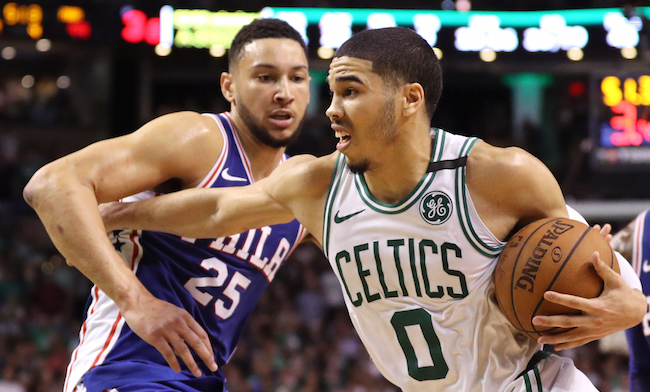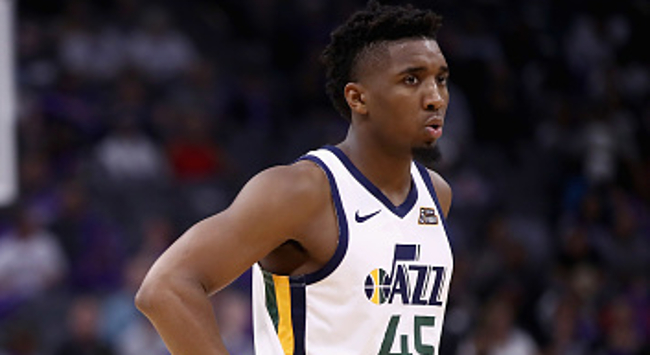
The 2017-18 Rookie of the Year race was one of the tightest and most competitive in recent memory. Ben Simmons took home the honors, but Donovan Mitchell and Jayson Tatum had compelling cases for the award as well, as both were also key players on playoff teams.
One of the storylines coming into the 2018-19 season was how that trio would follow up stellar rookie campaigns, and many expected them to build off of those years and take the next step towards being superstars in the NBA. However, through three weeks of their respective second seasons as professionals, it’s been a mixed bag for the trio and a not-so-friendly reminder that development of young players is far from a linear growth from year to year.
So often we want to project young players into what they will be in the future, assuming they all follow the same growth pattern. If a player is this good as a rookie, then he surely will be a superstar a few years from now … but that’s usually not the way it happens. There will be those that follow the path to superstardom, but sometimes players take steps back or plateau before going forward again, sometimes taking years before it clicks how to make that leap. Others will never make that jump and will tread water around the same level they entered the league, carving out careers as a quality role player while never living up to “star potential,” which is perfectly fine.
This can be a product of many things, from the development program and coaching of the team they’re on to simply garnering more attention from opponents who start gameplanning for them and are no longer taken by surprise as may have happened their rookie season. Whatever the case may be, player development isn’t as simple as people want to make it out to be, and early this season we’re getting a number of new examples of the difficulty in not just taking the next step but maintaining success in the NBA.

Mitchell is off to the best start of the three star rookies from a year ago, averaging 22.4 points and 4.1 assists per game, both increases over last year. But he’s struggled shooting the ball from the perimeter, hitting threes at a 31.6 percent clip. For a Utah team that, aside from Joe Ingles, is lacking in that department, his ability to stretch the floor and be a threat is important to their offensive success. The Jazz as a whole represent a cautionary tale of projecting steady growth from a full unit, as they have sputtered out of the gate thanks to some defensive regression after being one of the best defensive teams in recent memory a year ago.
In Boston, Tatum is likewise putting up better counting stats but struggling with his efficiency now that he’s being asked to shoulder a bigger load of the Celtics offense while teams are treating him like a major threat. The sophomore forward is averaging 15.7 points per game (up from 13.9 a year ago), but his shooting percentages are way down as he’s shooting 40.6 percent from the field and 34.9 percent from three-point range (a year ago those were 47.5 percent and 43.4 percent, respectively). Tatum isn’t alone, however, as his teammate Jaylen Brown has likewise struggled out of the gate in his third year in the league.
Brown made a spectacular leap in his second season, going from a role player to a starring role last season, but he’s not been able to replicate that success to this point in 2018-19. Brown is shooting 37.9 percent from the field and 29.7 percent from three to start the year on almost the exact same number of attempts as a year ago, and as such has seen his scoring drop from 14.5 points per game to 11.7 points per game this early season. Both Brown and Tatum’s struggles seem to be a product of new and uncomfortable roles with Kyrie Irving and Gordon Hayward working their way back into the rotation in Boston. No one on the Celtics, save for Irving and Marcus Morris, is off to a good offensive start, and it’s logical to expect the team (and in the process these two young stars) to work their way through it and figure things out.
Another casualty of a starting lineup shakeup from his stellar rookie campaign is Ben Simmons. The reigning Rookie of the Year is shooting 50 percent from the field, which is still good, albeit down from 54.5 percent from a year ago. However, the Sixers as a team have looked out of sync when he and Markelle Fultz have been paired together. The offense for Philadelphia comes to a grinding halt when that pair is on the court with an offensive rating of 89.3, the lowest of any two-man lineup with at least 60 minutes this season. Even though the defensive rating is a stout 95.5, that’s not good enough to make up for the horrific offensive numbers they’ve put up. The good news for Simmons is that Brett Brown seems to have realized that experiment isn’t going well and has leaned more on J.J. Redick next to Simmons, even if he’s yet to make the full switch to putting Redick back in the starting lineup.
None of this is to say these players aren’t going to improve from these starts or have excellent seasons again, but to serve to caution fans against automatically projecting leaps from their young stars. So much goes into a player’s success and things that may not seem huge on the outside, like shuffling around a starting lineup, can have a huge impact on their play. All of these young players are more than capable of making another leap into genuine superstardom, but for now they’re all dealing with the realities of being an NBA player and that the learning curve doesn’t just stop after that first year.
A great season puts a target on your back, and opposing staffs and players will pour over film to figure out how to slow you down, chase you off your spots, and generally make life more difficult for you. Now, it’s up to them to make the adjustments to internal and external changes on the court, dealing with the peaks and valleys along the way.






